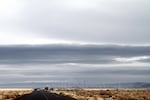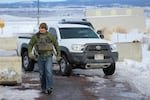
An FBI checkpoint outside the Malheur National Wildlife Refuge on Jan. 28, 2016.
Bradley W. Parks / OPB
Jeff Banta became the first defendant to testify in the trial of seven occupiers of the Malheur National Wildlife Refuge in eastern Oregon.
Banta’s testimony, which recounted the final days, hours and minutes of the 41-day occupation, broke the sometimes sterile environment of the federal courthouse in Portland.
Banta was one of the last four occupiers to surrender to the FBI along with Sean and Sandy Anderson, and David Fry. Thousands tuned in online to listen to the occupation’s dwindling moments as Fry contemplated ending his own life.
On the stand Thursday, Banta broke down as he described the tension.
“I wanted to leave,” he testified. “I didn’t want to hear a gunshot.”
Mounting Fear
The day the Bundys were arrested and occupation spokesman Robert “LaVoy” Finicum was killed — Jan. 26 — was a critical day in the timeline for Banta, Fry and the Andersons.
When they heard news of the arrests and Finicum’s killing, the remaining occupants began to fear what came next, according to Banta’s testimony. Banta said they worried law enforcement would move quickly on those left at the refuge.
“We had no trust in the FBI,” he said.

An FBI guard guides a truck out of the compound near the Burns Airport.
John Sepulvado / OPB
The Occupiers’ Mindset
The Rev. Franklin Graham served as a third-party negotiator between the last four occupiers and law enforcement during the final days. He also testified Thursday.
Graham, the son of famed evangelist Billy Graham, described the first phone conversation he had with the final four occupiers, which occurred Feb. 2.
“I wanted to help calm the situation,” he testified. “But I also wanted the FBI to take a deep breath.”
Graham’s testimony offered a glimpse into the mindset of the four occupiers in the final days.
The reverend testified memories of what happened at Ruby Ridge, Idaho, and Waco, Texas, were part of why he wanted to be involved in helping bring the occupation to a peaceful end.
Graham’s conversations with final occupiers intensified on Feb. 10 when he said the FBI told him they were ready to go in and make arrests. FBI agents requested Graham come to Oregon.
When Graham’s plane arrived in Burns the morning of Feb. 11, the FBI escorted him to the edge of the refuge before transferring him into an FBI BearCat to get closer to the occupiers. Perched about 100 feet from the group, Graham spoke to them from a loudspeaker.
After Banta and the Andersons were arrested, the FBI drove the BearCat back a bit, where Graham said he was able to meet those three, embrace them and tell them, “You did the right thing.”
Related: After Holdout, David Fry Surrenders
Graham also described Fry’s final hours as the last holdout. Speaking with Graham, Fry detailed violent thoughts he was having and said he was contemplating suicide. Graham said he offered the phone to Sandy Anderson to try to calm Fry down. She told him the agents were treating them all with respect and that they were safe, Graham testified.
It was still another hour before Fry eventually came out. But he did, peacefully, and Graham said when he did, two FBI negotiators walked over and joined them.
“They were just weeping uncontrollably, just thanking God that no one was hurt,” Graham said.